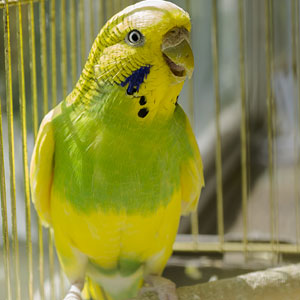
My First Bird
The Complete Guide to the Best Pet Bird Cages
It's your bird's "Home Tweet Home." That's why selecting the right bird cage is important to ensuring your feathered friend's comfort and safety.The Bigger the Better
Birds need space so it's recommended to get the largest cage that can be accommodated in your home. The main thing to consider when selecting a pet bird cage is your bird's size. Before starting your cage shopping, take measurements of the space you have available as well as any doorways. Don't forget to allow room for protruding feeders and flared cage aprons. If your cage will have to move through doorways, consider a knock-down type of cage that isn't welded and can be easily taken apart. If possible, put together the cage in the room where it will be used.In most cases, the cage should be wide enough to accommodate stretched wings; however, ample height should be provided for long-tailed birds. Since most birds aren't able to truly fly inside their cage, it's important to give your bird access to an exercise area outside of the cage for several hours each day.
The cage should be roomy enough to allow the bird to extend and flap her wings without coming into contact with the bars. Small birds should have enough room to fly around and larger birds should be provided with cages large enough to allow climbing and exercise.
Bird Cage Size Guidelines
Bigger is always better when it comes to your bird's cage. Here are some minimum cage size guidelines for some common birds:- Finch (pair): 24"l x 24"d x 24"h. Bar spacing - 1⁄2" or less.
- Canary (single): 24"l x 24"d x 24"h. Bar spacing- 5⁄8" or less.
- Budgies, lovebirds and parrotlets (single): 24"l x 24"d x 24"h. Bar spacing 1⁄2" or less. Flight cage should be 36" long.
- Cockatiel (single): 24"l x 24"d x 24"h inches. Bar spacing 3⁄4" or less.
- African grey (single): 36"l x 30"d x 48"h. Bar spacing ¾" to 1".
- Macaw (single): min. 48"l x 30"d x 60 to 72" h. Bars should have a diameter of ¼" and a spacing of 1 1⁄2" to 2". Two-inch spacing can make it easier to see the bird through the cage bars, but 1 1⁄2" spacing is better for their beaks.
Personality and Cages
What does your bird's personality have to do with their cage? A lot. Birds are smart and if you have a Houdini on your hands such as a cockatoo or a conure you'll want a cage with more security features. Meanwhile, if your bird loves to climb, consider a cage with lots of horizontal bars.Cage Design
Cages come in a variety of shapes. Rectangular cages are practical, easy to clean and fit well into most living spaces. Circular, pagoda, pyramid, round, "house" and even covered-wagon-shaped cages are usually available for small birds only. One side note, some bird owners and veterinarians recommend against round cages that have bars that are wide on the bottom and narrow at the top, saying it can pose a risk of your bird getting their wings or legs stuck between the bars and it doesn't allow a "safety corner" for your bird to retreat to.Outside access to food and water bowls is ideal, especially for larger birds. In addition, experts recommend looking for a cage with a large front door that is 60 percent or more of the cage front. A smaller inset door is also ideal.
It's important to keep in mind your bird won't be the only thing taking up space in his cage. Between perches, toys, water and food dishes, a cage that is just barely big enough when it's empty, may become a bit too crowded once accessories are added.
Bar Spacing
Bar spacing on any cage should be wide enough to prevent toes and limbs from being trapped, but not so wide that birds can stick their heads through them. Check cages with curved or domed tops to be sure that bars do not converge at the center. Welds should be smooth, with no rough edges that could hurt you or your bird.Choose Good-Quality and Strong Materials
Make sure the cage is made from materials that are strong enough to resist bending or dismantling. Also, certain fumes and materials can harm birds so make sure the cage is made of nontoxic material.The finish on the cage should be good quality. A good cage finish will last a while if your bird doesn't gnaw on the bars or constantly splash it with water. The finish on most cages can be maintained quite well with regular cleaning with a bird-safe cleaner like Poop-Off®. Acrylic cages are popular, but it's important to note, this material can become scratched.
Painted or powder coat finishes are usually durable, but stainless steel will typically last a lifetime. With the exception of stainless steel, all metal is subject to rust, discoloration or eventual corrosion. Never use metal polish on cages, as it can be toxic to birds. Over time, you will most likely see some wear as painted surfaces may scratch, chip, flake or stain.
Where Should I Place My Pet Bird's Cage?
You want your bird to feel safe and secure when in his cage. So placing the cage away from drafts and at eye level or higher will help make your feathered friend feel more comfortable. You want your feathered family member to be able to observe what you are all up to, without feeling like they are in the center of it all. The cage should be placed away from sources of intense heat or cold, such as windows, radiators, fireplaces, air conditioners and exterior doors.The kitchen is also another place to avoid. Cooking fumes and temperature fluctuations can be harmful. One fact to keep in mind, the fumes from overheated nonstick-coated cookware can actually be lethal to birds, so you may want to consider getting rid of pots, pans and any utensils coated with a nonstick surface.
Birds like some sun but direct sunlight is not recommended. Birds may become overheated. Consider placing a thermometer on the wall at cage level (but out of beak reach).
And don't forget about your other pets or household plants. Make sure your bird's cage is out of range of teeth, claws and certain toxic houseplants.
Does A "Mess-Free" Bird Cage Truly Exist?
Sorry to break it to you, but no. Birds are messy, it's a fact. But that's okay, we still love them. There are, however, some cage designs that do make clean up slightly easier. When looking at cages, find one where food and water dishes can be easily removed from the outside.When it comes to mess management features, angled cage aprons help direct cage fallout into the bottom tray. However, don't think these cage aprons catch everything. You'll still need to wipe poop and food from the surrounding area. Meanwhile, removable gratings make cleaning easier and keep birds out of dropped food and waste.
Cage Cleaning Schedule
Often the best defense against a mess is prevention. When selecting cage cleaning products, make sure they are bird safe. Some cleaning fumes can actually make a bird sick. Developing a regular cage cleaning schedule can save you time in the long run and help you stay one step ahead of the mess:- Daily: clean water and food dishes, replace paper tray liner, wipe cage apron.
- Weekly: wash the bottom grate.
What About a Used Cage?
Buying a used cage comes with risk. If you don't know the history of the cage it could create a dangerous and harmful environment for your bird.Used pet bird cages in antique shops or at garage sales may have been repaired or repainted with questionable materials. Many times these cages are designed as decorative cages and not intended for birds. They are often made of toxic materials, are unsafe and hard to clean.
If the cage was previously used by another bird, a contagious disease could spread to your bird if the cage wasn't cleaned properly.
Switching a Bird's Cage
Most birds are quite flexible when it comes to moving into a new home. But if your feathered friend seems a bit reluctant, try setting up the new cage near the old one so he can get used to the new one. Put some of his favorite toys and treats in the new cage and leave the door open so he can go in and out at will.Consider Getting Cage Replacement Parts
Nothing lasts forever, especially if a bird has anything to do with it. Most major manufacturers offer replacement parts such as perches, dishes and latches, but model numbers and designs change, so it might be a good idea to buy some replacement parts when you buy your new cage. That way you'll have them on hand for when you need them.There are a lot of factors to consider when choosing a cage. Don't just assume the cage in which you saw your bird in the pet shop is the correct size. Those cages may be used only for feeding or rest periods, and may not be suitable as long-term housing. Remember, the ideal cage size should allow your bird space to climb and walk around.
So now that you have found the perfect cage, the next question to ask is What Should I Feed My Bird?
Sources:
American Veterinary Medical AssociationAssociation of Avian Veterinarians
Pet Keepers Guide
Return to Bird Articles


